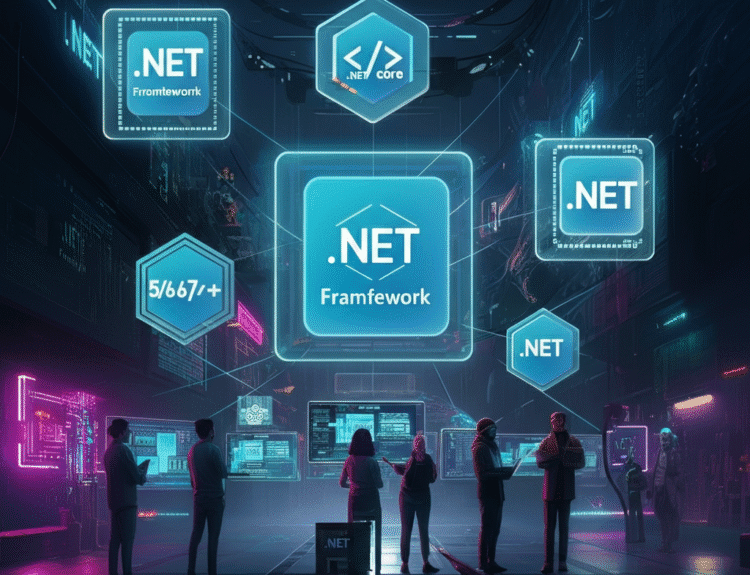The .NET ecosystem, a robust developer platform created by Microsoft, has consistently empowered developers to create cutting-edge software applications. From desktop and mobile apps to cloud-based solutions, Dotnet supports a wide range of projects with its variety of frameworks. Among these, .NET Framework, Dotnet Core, and .NET (5/6/7+) have sparked curiosity and debate about their capabilities, limitations, and use cases.
This article dives deep into the .NET ecosystem, compares its key frameworks, and provides actionable insights for .NET developers, software architects, and tech enthusiasts aiming to enhance their skills and make smart choices for their next project.
Introduction to the .NET Ecosystem
This ecosystem offers tools, languages, and libraries—including C# programming, Visual Basic, and F#—to build a wide variety of applications. Whether you’re developing for Windows, macOS, Linux, mobile platforms, or the web, this unified ecosystem provides everything you need across its key frameworks. The evolution of .NET includes:
- .NET Framework (Windows-only, 2002): Designed for building desktop and web applications.
- .NET Core (Cross-platform, 2016): An open-source framework enabling performance gains and broader compatibility.
- .NET (5/6/7+) (Unified, 2020+): A continuation and unification of it’s Core, featuring innovations for modern development.
Understanding these frameworks is crucial to leveraging the power of this development.
.NET Framework
What Is It?
The .NET Framework is a Windows-centric framework that has been a staple since its debut. It includes Common Language Runtime (CLR) for runtime execution and a massive class library for building diverse applications.
Key Features of this Framework
- Windows-first Compatibility: Ideal for developing legacy Windows applications using Web Forms, WCF, and LINQ .
- Rich Ecosystem: Integrated with many libraries, including Windows Communication Foundation (WCF) and Entity Framework.
- Development Efficiency: Offers debugging, diagnostics, and refactoring tools within Visual Studio.
Limitations of .NET Framework
The primary limitation of the .NET Framework is that it’s Windows-centric. Its lack of cross-platform capabilities restricts its use in modern, scalable applications.
Use cases often include maintaining legacy enterprise systems or building internal software solutions strictly aligned with Windows.
.NET Core
What Is It?
Introduced to resolve the constraints of the .NET Framework, .NET Core is a cross-platform, open-source development framework that empowers developers with flexibility, high performance, and modularity.
Key Features of .NET Core
- Cross-platform Deployment: Capable of running on Windows, macOS, and Linux.
- High Performance: Optimized for cloud and microservices in .NET, making it ideal for modern software solutions.
- Docker and Kubernetes: Seamless containerization for apps using advanced tools, including Kubernetes and Docker in .NET.
- Advanced APIs: With RESTful APIs in ASP.NET Core and SignalR for real-time communication, .NET Core boosts web app capabilities.
- Blazor and Razor Pages: Build modern, interactive web apps with Blazor using HTML, CSS, and JavaScript.
Best Use Cases for .NET Core
- Web Development: Building scalable applications like e-commerce websites with ASP.NET Core that run across multiple platforms.
- Cloud Solutions: Developing cloud applications integrated with Microsoft Azure.
- Microservices: Engineered for creating modular, lightweight, and independently deployable services.
.NET (5/6/7+)
What Is It?
.NET (5/6/7+), also known as the unified “.NET,” combines the strengths of .NET Core and the .NET Framework. Released in 2020, it reflects Microsoft’s long-term strategy for creating a single, cross-platform runtime.
Key Features
- Unified Platform: Empowers web, mobile, desktop, IoT, and cloud projects under one ecosystem.
- Native Support for Contemporary Tech: Enables cloud integration with Azure and leverages AI/ML libraries such as ML.NET.
- Entity Framework Core: Modern database integration with performance optimization in .NET applications.
- .NET MAUI: A cutting-edge tool that supports cross-platform mobile and desktop app creation.
- Improved Async/Await: Enhancements for cleaner, non-blocking C# programming with async/await in C# methods.
Why Choose .NET (5/6/7+)?
This unified framework offers consistency—ideal for companies transitioning from legacy systems to modern software methodologies.
Comparison of .NET Framework, .NET Core, and .NET (5/6/7+)
Here’s a quick comparison table highlighting key differences:
| Features | .NET Framework | .NET Core | .NET (5/6/7+) |
| Platform | Windows | Cross-platform | Cross-platform |
| Performance | Moderate | High | High |
| Microservices | Limited | Supported | Supported |
| Mobile Development | Unsupported | Xamarin | .NET MAUI |
| Cloud Integration | Basic | Advanced | Advanced |
| Legacy Support | Strong | Limited | Limited |
Practical Scenarios for Each Framework
Scenario 1 (Windows-first Legacy Systems): Maintaining large-scale internal systems for financial institutions? Stick with the .NET Framework.
Scenario 2 (Cross-Platform and Performance): Developing a new SaaS product or RESTful APIs with ASP.NET Core? Choose .NET Core for speed and scale.
Scenario 3 (Unified Development and Future-Proofing): Transitioning a multi-platform team to .NET development? Standardize across projects using .NET 6/7+.
Next Steps for .NET Developers
For developers or architects planning their next project, the key takeaway is to leverage the right .NET tool for the right job. .NET Framework excels in legacy applications; .NET Core is optimal for high-performance web solutions; and .NET (5/6/7+) offers a future-proof platform for unifying your technology stack.
Need further insights into secure coding practices in .NET, dependency injection in .NET, or performance optimization in .NET? Explore Microsoft’s official documentation, join developer communities like GitHub, and sign up for hands-on tutorials.




